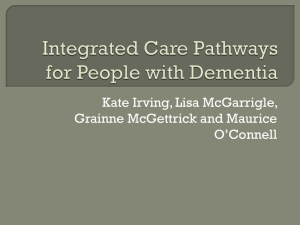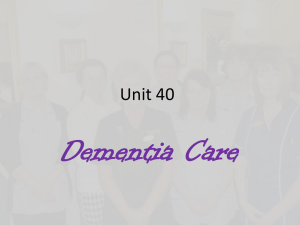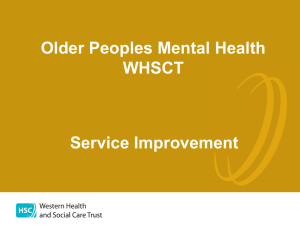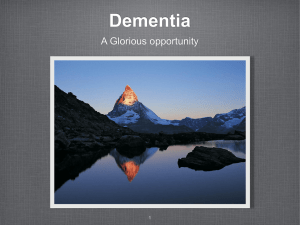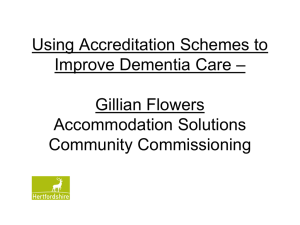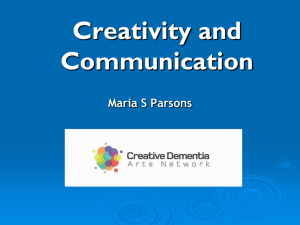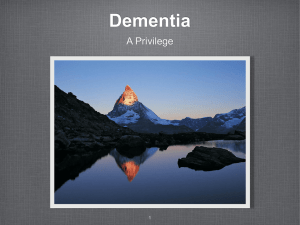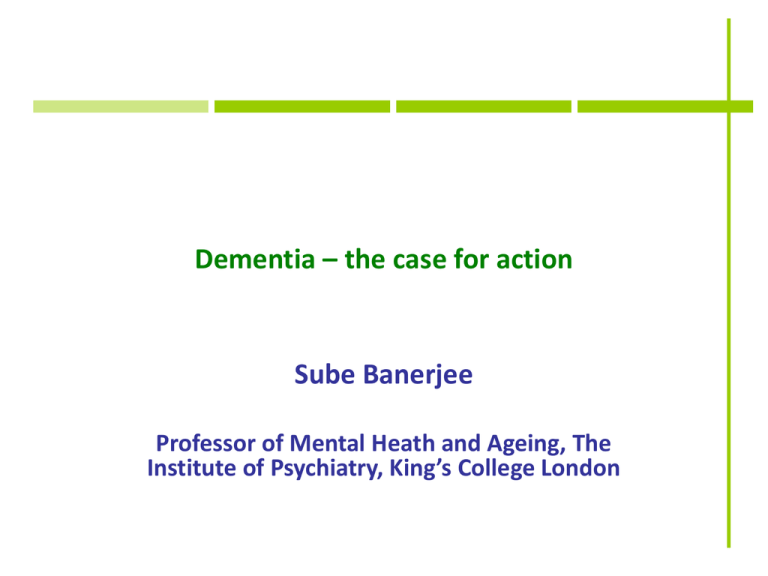
Dementia – the case for action
Sube Banerjee
Professor of Mental Heath and Ageing, The
Institute of Psychiatry, King’s College London
Growth of numbers of people with dementia
• The World Alzheimer Report
(2009) estimated:
– 35.6 million people living with
dementia worldwide in 2010
– Increasing to 65.7 million by 2030
– 115.4 million by 2050
Worldwide cost of dementia
•
•
•
The societal cost of dementia is
already enormous.
Dementia is already significantly
affecting every health and social
care system in the world.
The economic impact on families
is insufficiently appreciated.
•
The total estimated worldwide
costs of dementia are US$604
billion in 2010.
•
These costs are around 1% of the
world’s GDP
0.24% in low income
1.24% in high income
Worldwide costs of dementia
• The World Alzheimer
Report (2010)
estimated that:
If dementia care were a
country, it would be the
world’s 18th largest
economy
…so how are we doing?
6
“I’ve got it
too Omar… a
strange
feeling like
we’ve just
been going in
circles”
National dementia strategies
•
•
•
•
•
•
•
•
•
•
France
Wales
Scotland
Australia
Germany
Norway
Japan
South Korea
India
England
England - background
• Population 50 million
• 16% over 65
• Life Expectancy at Birth
– Males: 76.9 years
– Females: 81.1 years
• Religion
– Christian: 72%
– Jedi: 0.7%
– Sith: 0.001%
(350,000)
(500)
Overview of NHS
• Aneurin Bevan, on July 5 1948 set
three core principles:
– That it meet the needs of
everyone
– That it be free at the point of
delivery
– That it be based on clinical need,
not ability to pay
Independent NHS commissioning
board
GP commissioning
clusters (350+)
• 1.3 million workers
• Third (or fifth) largest employer in
the world
• £100 billion per year
• Social care a parallel system
Social
enterprises
Bringing it home, the local case - Dementia UK Report
simple messages – common and costly
Population prevalence (%) of dementia
by age
• Numbers with dementia
700,000
In 30 years – doubling
to 1.4 m
40
35
30
25
20
15
female
male
total
10
5
0
65-9
70-4
75-9
80-4
85-9
90-4
95+
• UK dementia cost £17billion pa
In 30 years – tripling
£51billion pa
Knapp et al (2007)
Dementia UK Report simple messages – under-recognised,
under-treated
Variation in treatment and diagnosis of
dementia in the UK
Variation in treatment and diagnosis of
dementia across Europe
60
24x variation
40
20
UK
Po
lan
Sl
ov
d
ak
R
Cz
ep
ec
h
Re
Ho p
lla
nd
Bu
lg
ar
ia
Ita
ly
Fr
an
c
Sw e
ed
en
Ire
lan
d
Sp
ain
Po
rtu
ga
Au l
st
ria
Be
lg
iu
m
De
nm
Sw
ar
k
itz
er
lan
Ge
d
rm
an
y
0
NAO Report – Value for money in dementia services - key
findings
• Size and nature of challenge
– Big and growing
– Doing nothing should not be a
strategic option
• Need for early diagnosis and
intervention
• Disjointed services in the
community
• Opportunities for increased cost
effectiveness
– “spend to save”
PAC report
PAC 8 findings
1.
2.
3.
4.
5.
6.
7.
8.
High priority
Explicit ownership and leadership
Early diagnosis
Improving public attitudes and understanding
Co-ordinated care
All for carers too
Improve care in care homes
Improve care in general hospitals
•
Presented by committee as its most
important report of the year
Review this year
•
National Dementia Strategy development
•
•
12 month programme
Develop
– National Dementia Strategy
– Implementation Plan
•
First explicit prioritisation
Programme
Board
Working
group
External
Reference
group
National Dementia Strategy - England
• Published 2 Feb 2009
• Five year plan
• 17 interlinked objectives
• £150 million extra funding
• Four key themes
•
•
•
•
Improving awareness
Early and better diagnosis
Improved quality of care
Delivering the Strategy
Objectives of the National Dementia Strategy
Improving public and professional awareness
and understanding
Sometimes what we
know is wrong
Dismantling the barriers to care: public and professional
attitudes and understanding
Good-quality early diagnosis and intervention for all
The fundamental problem - now
• Only a third at most of people
with dementia receive any
specialist health care assessment
or diagnosis
• When they do, it is:
–
–
–
–
Late in the illness
Too late to enable choice
At a time of crisis
Too late to prevent harm and crises
100%
80%
60%
40%
20%
0%
The solution
• 80% of people with dementia
receive specialist health care
assessment or diagnosis
• When they do, it is:
–
–
–
–
Early in the illness
Early enough to enable choice
In time to prevent harm
In time to prevent crises
100%
80%
60%
40%
20%
0%
Services for early diagnosis and intervention in
dementia for all
95% acceptance rate
94% appropriate referrals
• Working for the whole population
of people with dementia
– ie has the capacity to see all new
cases of dementia in their
population
• Working in a way that is
complementary to existing
services
– About doing work that is not
being done by anybody
• Service content
– Make diagnosis well
– Break diagnosis well
– Provide immediate support and
care immediately from diagnosis
19% under 65 years of age
18% minority ethnic
groups
Improvement in carerrated quality of life
Improvement in selfrated quality of life
92
100
91
98
90
96
89
94
88
87
baseline
6m
Decrease in
behavioral disorder
15
10
5
0
baseline
6m
92
70
60
50
40
%
30
20
10
0
baseline
6m
Proportion of new
cases diagnosed
2004
2006
2008
Banerjee et al 2007, IJGP
Providing early intervention services – what does good look
like?
1. Works for the whole population of people with dementia
– ie has the capacity to see all new cases of dementia in their
population
2. Works in a way that is complementary to existing services
– About doing work that is not being done by anybody
3. Service content
– Make diagnosis well
– Break diagnosis well
– Provide immediate support and care immediately from diagnosis
Priorities of people with dementia and carers from
the consultation
• O4. Enabling easy access to care, support and advice
following diagnosis
– dementia advisors – not being left alone by services on the
journey
• O5. Development of structured peer support and
learning networks
– third sector lead – who knows best?
Theme 3 - Improving quality of care
• O6. Improved community personal support services
– generic and specialist – collation of data
• O7. Implementing the Carers’ Strategy for people with dementia
– make it work for dementia
• O8. Improved quality of care for dementia in general hospitals
– clinical leads for dementia, specialist liaison teams – collation of data
• O9. Improved intermediate care for people with dementia
– change in guidance
• O10. Housing support, related services and telecare
– watching brief
• O11. Living well with dementia in care homes
– including review of use of antipsychotic medication in dementia
• O12. Improved end of life care for people with dementia
– making it work for dementia
Living well with dementia in care homes
Reduced use of antipsychotic medication
Ministerial review of use of antipsychotics in
dementia
•
Published November
2009
•
Comprehensive
review
–
–
•
•
Negative effects
Positive effects
Analysis of reasons for
current clinical
behaviour
Practical clinical plan
to deal with problems
found
New data and extrapolation
• NHS Information Centre for Health and • Estimates for the report
Social Care completed analyses using
the IMS Disease Analyzer
– 25% people with dementia
• Practices from England, Wales, Scotland
receiving an antipsychotic
and Northern Ireland a representative
UK sample by age and sex.
– 180,000 people with
dementia receiving an
• 1,098,627 patients 12-month period
antipsychotic
from 1 April 2007 to 31 March 2008.
– 192,190 people (17.5%) over the age of
65
– 10,255 (5.3%) received a prescription
for an antipsychotic.
– Includes people with
dementia at home as well as
people in care homes
Summary of risks and benefits at a population level of the use of atypical
antipsychotics for BPSD in people with dementia
• data suggest that treating 1,000 people with BPSD with
an atypical antipsychotic drug for around 12 weeks
would result in
– an additional 91–200 patients with behaviour disturbance
showing clinically significant improvement
– an additional 10 deaths;
– an additional 18 CVAEs,
» around half of which may be severe;
– no additional falls or fractures; and
– an additional 58–94 patients with gait disturbance.
• For UK
– 1,800 deaths per year
– 1,620 severe CVAEs per year
For Australia
•
700 deaths per year
•
600 severe CVAEs per year
Analysis of why
• Symptom of underlying system failure in health and social
care for people with dementia
• 1960s response to a 21st century challenge
• Why lack of response to clear warnings
– It is complicated
– System does not allow change
» Knowledge
» Attitudes
» Provision
• Simple stuff eg specialists shouting at GPS does not work
• Need to treat the cause as well as the symptoms
Action
Provision
of specialist
input
Use quality
improvement
mechanisms
Improve
skills in
primary and
social care
1. Use of quality improvement mechanisms
R1: Making the use of antipsychotics in
dementia a clinical governance
priority
• across the NHS.
• Using existing clinical governance
structures
• Medical Directors (or equivalent)
– all primary care trusts,
– all mental health trusts and
– all acute trusts
•
•
Review their level of risk in this area
Ensure that systems and services are
put in place to ensure good practice
in the
– initiation,
– maintenance and
– cessation of these drugs
R2: National leadership for reducing the
level of prescription of antipsychotic
medication for people with dementia
• Provided by the National Clinical
Director for Dementia,
• Work with local and national services.
• Report on a six-monthly basis to the
Minister of State for Care Services on
progress against the
recommendations in this review.
1. Use of quality improvement mechanisms II
R3: National and local audit
• Developed by the National Clinical
Director for Dementia with national
and local clinical audit structures and
leads,
• Audit to generate data on the use of
antipsychotics for people with
dementia in each PCT in England.
• Baseline audit should be completed
as soon as possible
R4: Improving quality and decreasing
quantity of prescribing
• clear, realistic but ambitious goals to
be agreed for the reduction of the
use of antipsychotics for people with
dementia.
– To one third of current level in three
years
•
– agreed and published locally
– reviewed yearly at
– April-July 2010
•
•
Generating baseline data across
England.
Repeated one, two and three years
later to gauge progress.
Explicit goals for improvement in
their use where needed,
• primary care trust,
• regional and
• national level,
•
Information published yearly on
progress towards them at each level.
1. Use of quality improvement mechanisms III
R9: Inspection
• CQC to consider using as markers
of the quality of care provided by
care homes and PCTs
– rates of prescription of
antipsychotic medication for
people with dementia,
– adherence to good practice
guidelines,
– availability of skills in nonpharmacological management of
BPSD
– the establishment of care home
in-reach from specialist mental
health services
• These data available by analysis
of local audit data and
commissioning decisions.
2. Improving skills
R5: Further research
• including
– clinical and cost effectiveness of
non-pharmacological methods
– other pharmacological
approaches as an alternative to
antipsychotic
• The National Institute for Health
Research and the Medical
Research Council should work to
develop programmes of work in
this area.
R6: Developing skills for GPs and
others working in care homes
• The Royal Colleges of General
Practitioners, Psychiatrists,
Nursing and Physician
• Curriculum for the development
of appropriate skills for GPs and
others working in care homes
• Equip them for their role in the
management
– complexity,
– co-morbidity and
– severity of mental and physical
disorder in those now residing in
care homes.
• Part of CPD
2. Improving skills II
R7: Curriculum for the development
of skills for care home staff
• inc non-pharmacological
treatment of behavioural disorder
in dementia
• deployment of specific therapies
• Senior staff in care homes should
have these skills and the ability to
transfer them to other staff
members in care homes.
• An NVQ in dementia care should
be developed
3. Specialist input
R8: Each PCT to commission
specialist older people’s mental
health in-reach services
• Supporting primary care in its
work in care homes.
• Commission as a new function
by PCTs
• Provided by specialist older
people’s mental health services
• Capacity to work routinely in all
care homes where there may be
people with dementia.
• May be aided by regular
pharmacist input into homes.
R11: Liaison for those in their
own homes
•
•
•
Contact between specialist older
people’s mental health services and
GPs
to plan how to address the issue of
people with dementia in their own
homes who are on antipsychotic
medication.
Using practice and patient-level data
from the completed audits on the
use of these medications, they
should agree
– how best to review and manage
existing cases and
– how to ensure that future use follows
best practice in terms of initiation,
dose minimisation and cessation.
3. Specialist input II
R10: Psychological therapies
for people with dementia
and carers
• IAPT programme to ensure that
resources are made available for
the delivery of therapies to
people with dementia and their
carers.
• Information and support should
be available to carers to give
them the skills needed to deploy
elements of non-pharmacological
care themselves in the home
What happened next…
• Not a lot…
What makes things happen?
commissioning
Operating Framework 2008/9
‘dementia:
providing people with dementia and their carers the best life
possible is a growing challenge, and is one that is becoming
increasingly costly for the NHS. Research shows that early
intervention in cases of dementia is cost-effective and can
improve quality of life for people with dementia and their
families. The Department will shortly be publishing details of
the clinical and economic case for investing in services for
early identification and intervention in dementia, which PCTs
will want to consider when developing local services ’
Operating Framework 2008/9
‘dementia:
providing people with dementia and their carers the best life
possible is a growing challenge, and is one that is becoming
increasingly costly for the NHS. Research shows that early
intervention in cases of dementia is cost-effective and can
improve quality of life for people with dementia and their
families. The Department will shortly be publishing details of
the clinical and economic case for investing in services for
early identification and intervention in dementia, which PCTs
will want to consider when developing local services ’
Operating Framework 2009/10
60. There have been a number of important 62. The National Dementia Strategy will
developments in the last year within the
be a comprehensive framework
context of High Quality Care for All that
aimed at driving up standards of
will help PCTs determine how they
health and social care services to
develop and implement their local plans.
improve the quality of life and
These cover the following areas:
quality of care for people with
dementia and their carers. PCTs will
want to work with local authorities
• alcohol;
to consider how they could improve
• dementia;
dementia services.
• end of life care;
• mental health;
3.30 Nationally, there is a range of tools
• military personnel, their dependants and
to assist PCTs and specialised
commissioning groups in delivering
veterans;
their priorities as world class
• mixed-sex accommodation;
commissioners. These include, but
• people living in vulnerable circumstances;
are not limited to: the developing
and
National Support teams (NST) for
health inequalities, tobacco,
• people with learning disabilities.
alcohol, infant mortality, teenage
pregnancy, sexual health,
vaccinations and dementia…
Revision to the Operating Framework for the NHS in
England 2010/11
• One of only two new specific priorities
• 13. During the recent sign-off of SHAs plans, two areas stood
out as not being given sufficient emphasis. The first is
ensuring that military veterans receive appropriate
treatment… The second area is dementia. NHS organisations
should be working with partners on implementing the
National Dementia Strategy. People with dementia and their
families need information that helps them understand their
local services, and the level of quality and outcomes that they
can expect. PCTs and their partners should publish how they
are implementing the National Dementia Strategy to increase
local accountability for prioritisation.
Revision to the Operating Framework for the NHS in
England 2010/11
• One of only two new specific priorities
• 13. During the recent sign-off of SHAs plans, two areas stood
out as not being given sufficient emphasis. The first is
ensuring that military veterans receive appropriate
treatment… The second area is dementia. NHS organisations
should be working with partners on implementing the
National Dementia Strategy. People with dementia and their
families need information that helps them understand their
local services, and the level of quality and outcomes that they
can expect. PCTs and their partners should publish how they
are implementing the National Dementia Strategy to increase
local accountability for prioritisation.
Quality outcomes for people with dementia: building on the
work of the National Dementia Strategy (DH, 2010)
‘There are four priority areas for the Department of Health’s policy development work during
2010/11 to support local delivery of the Strategy. These areas provide a real focus on activities
that are likely to have the greatest impact on improving quality outcomes for people with
dementia and their carers. It is important to emphasise however that the priorities are
enablers for local delivery of the Strategy in full, across all 17 objectives, as well as the work to
implement the recommendations of the report in to the over-prescribing of antipsychotic
medicines to people with dementia.
The four priority areas are:
–
Good quality early diagnosis and intervention for all - Two thirds of people with dementia never receive
a diagnosis; the UK is in the bottom third of countries in Europe for diagnosis and treatment of people
with dementia; only a third of GPs feel they have adequate training in diagnosis of dementia.
–
Improved quality of care in general hospitals - 40% of people in hospital have dementia; the excess cost
is estimated to be £6m per annum in the average General Hospital; co-morbidity with general medical
conditions is high, people with dementia stay longer in hospital.
–
Living well with dementia in care homes - Two thirds of people in care homes have dementia;
dependency is increasing; over half are poorly occupied; behavioural disturbances are highly prevalent
and are often treated with antipsychotic drugs.
–
Reduced use of antipsychotic medication - There are an estimated 180,000 people with dementia on
antipsychotic drugs. In only about one third of these cases are the drugs having a beneficial effect and
there are 1800 excess deaths per year as a result of their prescription.’
Quality outcomes for people with dementia: building on the
work of the National Dementia Strategy (DH, 2010)
‘There are four priority areas for the Department of Health’s policy development work during
2010/11 to support local delivery of the Strategy. These areas provide a real focus on
activities that are likely to have the greatest impact on improving quality outcomes for people
with dementia and their carers. It is important to emphasise however that the priorities are
enablers for local delivery of the Strategy in full, across all 17 objectives, as well as the work
to implement the recommendations of the report in to the over-prescribing of antipsychotic
medicines to people with dementia.
The four priority areas are:
–
Good quality early diagnosis and intervention for all - Two thirds of people with dementia never receive
a diagnosis; the UK is in the bottom third of countries in Europe for diagnosis and treatment of people
with dementia; only a third of GPs feel they have adequate training in diagnosis of dementia.
–
Improved quality of care in general hospitals - 40% of people in hospital have dementia; the excess cost
is estimated to be £6m per annum in the average General Hospital; co-morbidity with general medical
conditions is high, people with dementia stay longer in hospital.
–
Living well with dementia in care homes - Two thirds of people in care homes have dementia;
dependency is increasing; over half are poorly occupied; behavioural disturbances are highly prevalent
and are often treated with antipsychotic drugs.
–
Reduced use of antipsychotic medication - There are an estimated 180,000 people with dementia on
antipsychotic drugs. In only about one third of these cases are the drugs having a beneficial effect and
there are 1800 excess deaths per year as a result of their prescription.’
DH commissioning packs (Landsley 2010)
Commissioning packs are tools to help commissioners improve
the quality of services for patients, through clearly defined
outcomes that help drive efficiency by reducing unwarranted
variation in services.
– Each pack contains a set of tailored guidance, templates, tools and information to assist
commissioners in commissioning healthcare services from existing providers, or for use
in new procurements.
– Integral to each pack is an evidence-based service specification which ensures that
patients are placed at the forefront of the service and are central to decisions about their
care.
– The specification is non-mandatory and can be adapted to reflect local needs and once
agreed with the provider should inform part of a renegotiated contract or form the
relevant section of the NHS standard contract.
– By bringing together the clinical, financial and commercial aspects of commissioning in
one place, the packs simplify processes and minimise bureaucracy.
1. Cardiac rehabilitation – Oct 2010
2. Dementia – March 2011
3. Chronic obstructive pulmonary disease
What happens next…
• High likelihood of central
pressure for change
• Increasingly localised
decision-making/
commissioning
• What will be the effect of
cessation without support?
• Interesting times, but never
a better chance for possible
positive change
1. Use quality
improvement
mechanisms
3. Provision
of specialist
input
2. Improve
skills in
primary and
social care
Distribution of DEMQOL scores by CDR score
110.00
DEMQOL score
100.00
90.00
80.00
70.00
60.00
0.50
1.00
1.50
2.00
cdr score
2.50
3.00
Money
clinical/cost effectiveness
Early intervention for dementia is clinically and cost
effective – “spend to save”
– £7 billion pa
•
•
•
•
•
22% decrease in care home use with
early community based care
28% decrease in care home use with
carer support (median 558 days less)
250
Take an additional 220 million pa
Delayed benefit by 5-10 years
Model published by DH
20% releases £250 million pa y6
200
150
100
50
0
1
2
3
4
5
6
7
8
9
10
Years
Costs to health & social care
Public sector savings
Societal savings
ESTIMATED COSTS AND SAVINGS: 20% VARIANT
Quality – older people want to stay at
home, higher qol at home
– Strategic head needed
•
•
ESTIMATED COSTS AND SAVINGS: 10% VARIANT
300
Costs & Savings (£m)
•
215,000 people with dementia in care
homes -- £400 per week
Spend on dementia in care homes pa
600
500
Costs & Savings (£m)
•
400
300
200
100
0
1
2
3
4
5
6
7
8
9
10
Years
Costs to health & social care
Public sector savings
Societal savings
Cost effectiveness
• The Net Present Value would be positive if benefits (improved quality of life),
rose linearly from nil in the first year to £250 million in the tenth year. This
would be a gain of around 6,250 QALYs in the tenth year, where a QALY is
valued at £40,000, or 12,500 QALYS if a QALY is valued at only £20,000.
Please ignore – not English - economics
• By the tenth year of the service all 600,000 people in England then alive with
dementia will have had the chance to be seen by the new services
• A gain of 6,250 QALYS per year around 0.01 QALYs per person year. A gain of
12,500 QALYS around 0.02 QALYs per person year.
• Likely to be achievable in view of the rise of 4% reported from CMS.
• Needs only:– a modest increase in average quality of life of people with dementia,
– plus a 10% diversion of people with dementia from residential care, to
be cost-effective.
Banerjee and Wittenberg (2009) IJGP
• The net increase in public expenditure would then, be justified
by the expected benefits.
Success in quality improvement in dementia requires
• Vision
• System change
• Ambition in scale
• Investment
• Commitment over time
• Leadership
Dementia care pathway – simple, navigable
and commissionable
primary
care
Help
seeking
social
care
DIAGNOSIS
specialist
care
specialist
older people’s mental health
services
social care
community &
care homes
Acute trusts
1. Encourage help
seeking and
referral
2. Locate responsibility
for early diagnosis and
care
primary
care
Peer & voluntary
Sector support
3. Enable good quality
care tailored to
dementia
Thank you!



